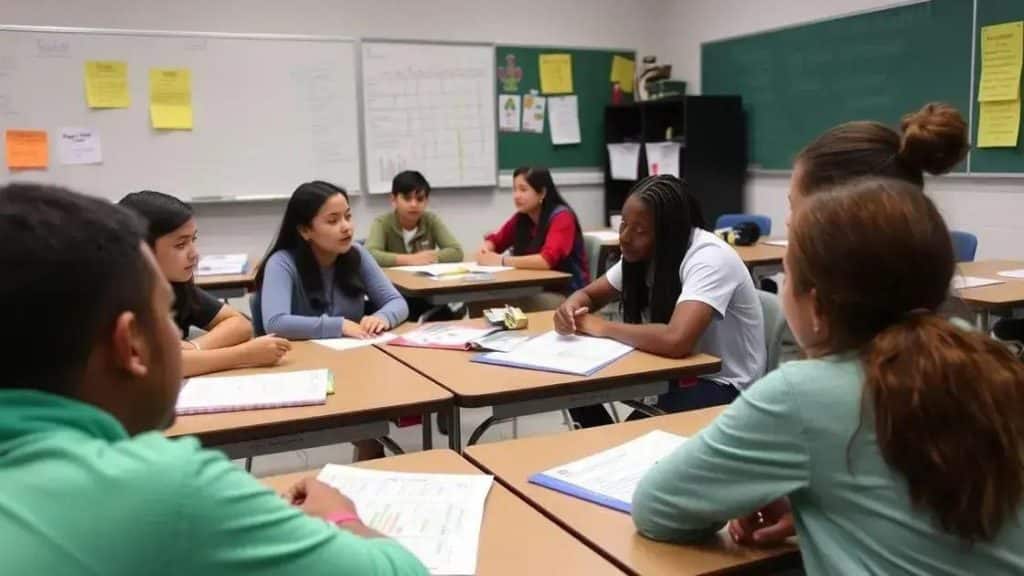Full financial literacy in schools: why it matters

Full financial literacy in schools equips students with essential money management skills, fostering informed decision-making and financial stability for their futures.
Full financial literacy in schools is crucial for preparing students to manage their finances effectively. Have you ever wondered how teaching budgeting and saving skills could change a student’s life? Let’s dive into why this education deserves more attention.
The importance of teaching financial literacy
The importance of teaching financial literacy in schools cannot be overstated. It equips students with essential skills to manage their money effectively.
Young people are often unaware of how to budget, save, or invest. This knowledge is vital for their future financial health. By integrating financial education into the curriculum, schools can prepare students for real-world challenges.
Key Benefits of Financial Literacy Education
Teaching financial literacy offers several advantages. It promotes financial well-being and helps students make informed decisions:
- Empowers students to take control of their finances.
- Fosters a healthy understanding of credit and loans.
- Encourages wise spending habits.
- Prepares students for unexpected financial challenges.
When students grasp the concept of financial literacy, they are more likely to avoid common pitfalls like unnecessary debt. They learn to prioritize savings, showing them the importance of planning for the future.
Moreover, early education regarding money can lead to more responsible adults. This knowledge shapes behaviors and attitudes towards money management, leading to greater financial stability.
Integrating Financial Literacy into School Programs
Schools can adopt various strategies to integrate financial literacy effectively:
- Include it as a dedicated subject in the curriculum.
- Utilize real-world applications through projects.
- Invite guest speakers from financial institutions.
- Incorporate online resources and interactive tools.
With these approaches, educational institutions can create a strong foundation for financial understanding that lasts a lifetime. A commitment to financial literacy in schools helps build economically savvy citizens.
Key concepts every student should learn
There are several key concepts that every student should learn to achieve strong financial literacy. Understanding these concepts is essential for effective money management now and in the future.
One fundamental idea is the difference between needs and wants. Recognizing this distinction helps students prioritize their spending. For example, necessities like food and housing should come before luxury items. This basic skill lays the groundwork for budgeting and responsible spending.
Understanding Budgeting
An essential part of financial literacy is learning how to budget. Budgeting helps students track their income and expenses, allowing them to manage their money better:
- Identify all sources of income.
- List monthly expenses accurately.
- Set spending limits to avoid overspending.
- Adjust the budget based on changing needs.
Students who master budgeting are more likely to stay within their limits. They learn the importance of saving for emergencies and future goals.
The Basics of Saving and Investing
Understanding saving and investing is another critical component. Learning how to save money and why it matters can pave the way for financial success:
- Explain the importance of having an emergency fund.
- Introduce basic investing concepts, like stocks and bonds.
- Discuss the benefits of starting to save early.
- Highlight compound interest and its long-term benefits.
These concepts help students see the value in making their money work for them. With this foundation, they can achieve financial stability and wealth over time.
Finally, understanding credit is vital. Students should learn about credit scores, how to build good credit, and the consequences of poor credit management. Knowledge of credit can empower them to make informed decisions regarding loans and other financial products.
How financial literacy impacts future decisions

Understanding how financial literacy impacts future decisions is crucial for students. The skills they learn today shape their choices tomorrow.
When students are equipped with financial knowledge, they become more informed decision-makers. They are better prepared to manage their money, avoid debts, and invest wisely. These abilities can directly influence their quality of life in adulthood.
The Role of Financial Literacy in Career Choices
Financial literacy can also affect career decisions. Many students may choose professions that offer better salaries, knowing how to evaluate compensation packages. Understanding finances allows them to negotiate salaries effectively:
- Learn to assess job offers based on overall benefits.
- Recognize the importance of retirement plans.
- Evaluate health insurance options.
- Consider costs of commuting and work-related expenses.
By grasping these factors, students can make choices that align with their financial goals.
Investing in the Future
A strong foundation in financial literacy guides students not just in their careers but also in personal investments. When they learn about saving and investing early, it sets them up for long-term success:
- They understand the benefits of compound interest.
- They can make smart choices about stocks and bonds.
- They recognize when to take calculated risks.
- They are more likely to save for future needs like college or buying a home.
This knowledge encourages them to build wealth over time, allowing for financial freedom.
Consequently, those with strong financial literacy tend to avoid pitfalls like excessive debt and poor financial planning. Their understanding translates into smarter choices regarding loans, mortgages, and other financial commitments.
Ways schools can integrate financial education
There are many effective ways schools can integrate financial education into their programs. By adopting various strategies, educators can ensure that students gain the essential skills needed for their financial futures.
One method is to include financial literacy as a dedicated subject in the curriculum. This ensures that every student receives structured learning on topics such as budgeting, saving, and investing. Schools can introduce this as early as elementary grades to build a strong foundation.
Hands-On Learning Opportunities
Experiential learning can significantly enhance understanding. Schools can organize projects that require students to create budgets for hypothetical events.
- Students can plan a school event and manage funds.
- Simulated stock market games can teach investing.
- Managing a class fund can introduce real-life financial concepts.
- Field trips to local banks or financial institutions provide practical insights.
These hands-on experiences make learning about money management exciting and relevant.
Guest Speakers and Workshops
Another approach is to invite guest speakers from financial professions. These individuals can share real-world experiences and valuable insights:
- Finance professionals can demystify subjects like credit scores and loans.
- Workshops can educate students on creating personal budgets.
- Counselors can guide students on navigating financial aid for college.
- Short courses on investment can spark interest in financial markets.
Such interactions can reinforce classroom learning and inspire students to take financial literacy seriously.
Schools can also integrate technology by using educational apps. Many platforms provide interactive lessons on financial literacy that engage students. Incorporating technology helps to modernize the learning experience and make it more appealing to digital natives.
Success stories of financial literacy programs
Success stories of financial literacy programs can inspire schools to adopt similar initiatives. These programs have proven effective in educating students about money management.
A great example is a program implemented in a high school that focused on practical financial skills. Students learned how to budget for a month, set savings goals, and understand credit. As a result, many students reported feeling more prepared to handle their finances after graduation. Their confidence grew, knowing they could manage their money successfully.
Case Study: Junior Achievement
One notable success story comes from Junior Achievement, which has reached millions of students worldwide. This program provides hands-on experiences that teach financial literacy, work readiness, and entrepreneurship:
- Students participate in simulated business challenges.
- They learn from local business professionals who share real-world experiences.
- Programs are tailored to different age groups, ensuring relevance.
Participating students often show improved scores on financial literacy assessments, demonstrating the program’s effectiveness.
Community Programs Making an Impact
Another inspiring example comes from local community initiatives. Many communities have partnered with financial institutions to offer workshops:
- These workshops cover essential topics such as budgeting, saving, and investing.
- Families can attend classes together, reinforcing learning at home.
- Participants often receive free resources like budgeting templates and financial guides.
Feedback from these programs shows participants feel more empowered in their financial choices, which is a testament to the impact of financial literacy education.
By showcasing these success stories, schools can see the tangible benefits of implementing financial literacy programs. Students who engage in these programs develop valuable skills that last a lifetime, highlighting the importance of making financial education a priority.
FAQ – Frequently Asked Questions about Financial Literacy in Schools
Why is financial literacy important for students?
Financial literacy equips students with essential skills for managing money, making informed decisions, and preparing for their futures.
What are some effective ways to teach financial literacy?
Schools can use hands-on projects, interactive games, and real-world experiences to engage students in financial education.
How do financial literacy programs impact students’ lives?
These programs empower students to avoid debt, save for emergencies, and invest wisely, leading to better financial stability.
What resources are available for implementing financial literacy in schools?
There are many resources, including curriculum guides, community partnerships, and online tools that support financial education.





